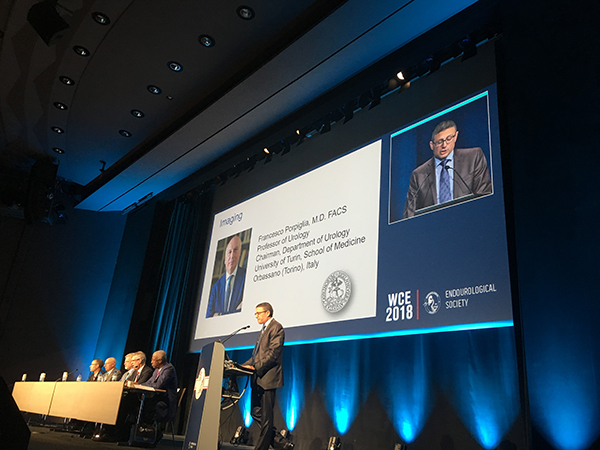Professor Porpiglia shared the incredible innovations in small renal mass imaging. Improvements in diagnosis, morphometric feature evaluation, surgical planning, and postoperative renal function evaluation were reviewed. While CT imaging remains the reference standard, Dr. Porpiglia noted that in some cases complimentary imaging modalities such as multiparametric MRI are helpful. He reviewed exciting recent developments including virtual and augmented reality which is showing great promise. While imaging has advanced, he conceded that it is still limited in its ability to differentiate between small renal mass histopathology.
Professor Obek followed with a comprehensive review of renal cortical neoplasm biopsy. Biopsy should be performed with an 18-gauge needle and he recommended a coaxial sheath with the theoretical advantage of minimizing seeding events. He noted that while rarely used by a urologist in a pre-operative setting, that renal mass biopsy is generally safe with a low complication rate and that biopsy is effective in determining histopathology, albeit with a limited capacity (62.5%) to establish grade accurately. He concluded that, "Renal mass biopsy should take place more than never, but less than always."
Dr. David Duchene then reviewed the current state-state-of-the-art on active surveillance and noted that there has been a tendency toward over diagnosis and over the treatment of the small renal mass. He quoted data from the JNCI noting a large increase in the incidence of small renal mass diagnosis with a commensurate increase in treatments, but with no diminishment in the death rate from renal cell carcinoma, and he suggested that we are "spinning our wheels" with limited value. In a slide entitled, "First, do no harm" he stated that we need to think beyond surgery for selected small renal masses. He then reviewed the DISSRM trail which has shown no difference in disease-specific survival for active surveillance versus primary intervention in this non-randomized trial. Dr. Duchene concluded that most small renal masses are indolent, that active surveillance seems to be non-inferior to treatment for selected tumors and that we as a community should consider a change in our thought processes around small renal mass management similar to what has happened with active surveillance for low-grade prostate cancer.
Professor Herrell closed with his review of treatment strategies. He noted that the updated AUA guidelines published in 2017 continue to prioritize partial nephrectomy which, when compared to radical nephrectomy offers equal oncologic control and postoperative morbidity, but with improved renal function and quality of life. He reviewed the controversies still surrounding partial nephrectomy including the type of vessel clamping and acceptable ischemia times. After a review of partial nephrectomy techniques, Dr. Herrell reviewed ablation noting that the 2017 AUA guidelines review demonstrated that recurrence-free survival for ablation is superior to that of partial nephrectomy when multiple ablation procedures are included in the analysis.
After listening to this summary of the state-of-the-art for the small renal mass I noted that it was clear that we have made tremendous strides in our understanding and use of imaging, biopsy, active surveillance and treatment strategies. It is clear however that our greatest opportunity in the treatment of the small renal mass remains in pre-treatment biopsy. I noted that data presented from our UC Irvine minimally invasive laboratory group at this WCE meeting has shown that when compared to biopsies of all other organ systems (thyroid, lung, breast, liver and prostate), renal cortical neoplasm biopsy is equal or safer with regards to complications, and equal or more efficacious than biopsies in other organs. Whereas all other surgeons in all other organ systems use biopsy 100% of the time prior to active management, Urology uses biopsy of the small renal mass only 7% of the time. The opportunity to improve patient care with more precise and thoughtful biopsy driven decision processes is at our fingertips (or perhaps biopsy needle tips).

Written by: Jaime Landman, MD, Professor of Urology and Radiology, Chairman, Department of Urology, University of California, Irvine at the 36th World Congress of Endourology (WCE) and SWL - September 20-23, 2018 Paris, France
Read: State of the Art: Small Renal Masses – Active Surveillance by David Duchene, MD
Read: State of the Art: Small Renal Masses - Imaging by Francesco Porpiglia, MD
Read: State of the Art: Small Renal Masses – Latest in Partial Nephrectomy, Duke Herrell, MD
Read: State of the Art: Small Renal Masses - Office Biopsies, Can Obek, MD


